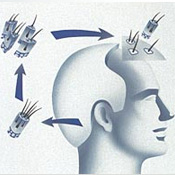!




Hair Transplantation
People normally lose between 80 and 150 hair strands per day. This is well noticed in our everyday life when showering, combing or brushing our hair. This is a natural hair renewal process. Any hair loss exceeding that number is abnormal and requires consultation with a dermatologist and a medical treatment. If the hair loss is not influenced by the treatment applied, the only permanent solution is the surgical technique of hair transplantation.
Hair Transplantation, more popular as ‘hair transplant’ and also known as ‘hair restoration’ is often referred to as cosmetic or aesthetic surgery. The process involves transplantation of patient’s own existing hair (grafts), by taking it from one area of the scalp with stable hair growth and moving it to another, usually with missing or thinning hair. The same procedure is also applied for facial hair restoration such as eyebrows, beard and moustaches.
Modern hair transplantation is a comfortable and risk free procedure, performed successfully for more than forty years, producing efficient and pleasing results for most of the patients. A completely natural hair appearance can be achieved with the help of new and improved hair transplant techniques such as usage of follicular unit grafts and mini-micro grafts. Latest developments in surgical hair restoration allow a considerable quantity of grafts to be transplanted with reduced number of operations.
Most patients suffering from advanced hair loss turn to a hair transplant surgery as a last resort of hope, only after all other treatment methods have been exhausted which is completely normal and understandable. However when reviewing all the costs made for inefficient products, the lost time and frustration caused, the majority regrets to have not underwent a surgical hair restoration procedure any earlier.
Am I a suitable candidate for a hair transplant surgery?
A good candidate for a hair transplant procedure should have enough hair located on the back or on the sides of the scalp that can be used for donor grafts. The donor site must be stable which means not affected by the DHT. The donor hair should be sufficient to fill in the bald areas without causing the donor area to bald itself. The thicker the hair in the donor area is the more natural appearance can be achieved after the hair transplant operation. Other major concerns are patient’s age and the stage to which the hair loss has advanced. It is desirable the patient to be at a stage of his life when the pattern baldness is evident or is likely to become more severe and progressive. The angle and direction of hair growth in donor area is also of importance for the final results and should be similar to the original pattern of hair growth in the recipient area. Normally your hair transplant surgeon will be able to evaluate your candidacy better after seeing you in person and upon performing the necessary examination.
In addition the right candidate for hair transplantation should also have realistic expectations about the upcoming procedure and also possess the necessary motivation to undergo a surgical hair restoration. For the suitable candidate, a hair transplant surgery can prove to be immensely beneficial for his/her appearance, self image and sense of well-being.
The best candidates for hair transplant surgery are:
Men whose male pattern baldness has progressed to level 3 from the Norwood scale
Men who have been experiencing constant hair loss for years
Men and women who have lost hair because of trauma, injury or chemical burns
Men and women with hair loss due to other cosmetic procedure such as face-lifts.
While almost 90% of men make a good candidate for the procedure, very few women are suitable to undergo a hair transplant surgery. This is due to the diffuse pattern of hair loss, which makes it very hard to find stable donor areas, unaffected by the DHT enzyme.
Still some women can benefit from hair transplant surgery if they meet the following criteria:
Women with hair loss is caused by mechanical or traction Alopecia (non hormonal)
Women with pattern of baldness featuring hairline recession, vertex thinning, and stable donor area
Women with alopecia marginalis, a condition very much alike the traction alopecia.
Possible Risks:
The overall risks of undergoing a hair transplant surgery are minimal. These are limited to a possible allergic reaction to the anaesthesia or an infection in the rarest cases. Some patients bear the risk of losing some of their existing hair due to a ‘shock loss’ triggered by the trauma of surgical intervention. The most serious risk however remains the dissonance between patient’s expectations and the actual outcome of the operation. The results may not always be exactly what patient expects therefore it is essential for the patient to be properly motivated and have realistic expectation before the procedure.
